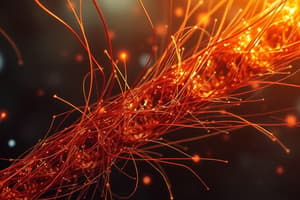Podcast
Questions and Answers
What does 'amorphous' mean in relation to fibers?
What does 'amorphous' mean in relation to fibers?
Without a defined shape; fibers composed of a loose arrangement of polymers that are soft, elastic, and absorbing.
What does 'crystalline' mean in the context of fibers?
What does 'crystalline' mean in the context of fibers?
Geometrically shaped; fibers composed of polymers packed side by side, making them stiff and strong.
What is 'direct transfer'?
What is 'direct transfer'?
The passing of evidence, such as a fiber, from victim to suspect or vice versa.
Define 'fiber'.
Define 'fiber'.
What is a 'mineral fiber'?
What is a 'mineral fiber'?
What is a 'monomer'?
What is a 'monomer'?
What is a 'natural fiber'?
What is a 'natural fiber'?
Define 'polymer'.
Define 'polymer'.
What does 'secondary transfer' mean?
What does 'secondary transfer' mean?
Define 'synthetic fiber.'
Define 'synthetic fiber.'
What is a 'textile'?
What is a 'textile'?
What is 'warp' in weaving?
What is 'warp' in weaving?
What is 'weft'?
What is 'weft'?
What does the term 'yarn (thread)' refer to?
What does the term 'yarn (thread)' refer to?
What does fiber represent in terms of evidence?
What does fiber represent in terms of evidence?
Why must fibers be collected within 24 hours?
Why must fibers be collected within 24 hours?
What is the process for collecting fiber evidence?
What is the process for collecting fiber evidence?
What does 'sampling fiber evidence and analysis testing' entail?
What does 'sampling fiber evidence and analysis testing' entail?
What factors are evaluated in fiber evidence?
What factors are evaluated in fiber evidence?
Differentiate between natural fibers and synthetic fibers.
Differentiate between natural fibers and synthetic fibers.
What are plant fibers composed of?
What are plant fibers composed of?
What are mineral fibers?
What are mineral fibers?
What is a regenerated fiber?
What is a regenerated fiber?
What defines synthetic polymer fibers?
What defines synthetic polymer fibers?
What are the advantages of synthetic fibers?
What are the advantages of synthetic fibers?
How does weaving relate to textiles?
How does weaving relate to textiles?
Study Notes
Fiber Types and Properties
- Amorphous Fibers: Lack defined shape, soft and elastic, like cotton.
- Crystalline Fibers: Geometrically structured, stiff and strong, like flax.
- Natural Fibers: Sourced from animals, plants, or minerals, composed of polymers.
- Synthetic Fibers: Manufactured from substances like plastics; categorized as regenerated fibers and synthetic polymer fibers.
Fiber Transfer Methods
- Direct Transfer: Evidence (e.g., fibers) passed directly between victim and suspect.
- Secondary Transfer: Fibers transferred from a source to a suspect, then to a victim.
Fiber Collection and Evidence Protocol
- Collect fibers within 24 hours to prevent loss (95% fiber loss estimate).
- Use tape, forceps, or a vacuum for collection; fibers are placed on clean paper and sealed in evidence bags.
- Record precise locations of fiber evidence for admissibility in court.
Fiber Analysis Techniques
- Use visual identity (color, shape) to classify fibers.
- Analyze fibers with non-destructive methods: polarizing light microscopy, infrared spectroscopy, microspectrophotometry, and ultraviolet light analysis.
Evaluating Fiber Evidence
- Assess fiber type, color, quantity, location of find, and textile origin.
- Consider multiple transfers and the type of crime to contextualize fiber significance.
- Time between crime and fiber discovery affects evidence reliability.
Fiber Classification Overview
- Natural Fibers: Derived from animal (protein-based), plant (cellulose), or mineral sources; include seed (cotton), leaf (manila), stem (flax), and fruit (coir) fibers.
- Synthetic Fibers: Include several types such as rayon, nylon, and polyester, derived from petroleum; strong but can degrade in sunlight.
Special Fibers and Their Uses
- Animal Fibers: Protein-based, include wool from sheep or silk from silkworms; used in textiles and bedding.
- Plant Fibers: Composed mainly of cellulose; can be thick or fine, often brittle, with common sources including cotton and flax.
- Mineral Fibers: Not composed of proteins or cellulose; includes fiberglass (insulation) and asbestos (historically used in building materials).
Yarn and Textile Production
- Yarns: Formed by spinning shorter fibers; can be combined for desired strength or texture.
- Textiles: Created through weaving; historical origins trace back to early human developments in the Stone Age with flax and animal fibers.
General Characteristics
- Fibers must be considerably longer than wide; typically 100 times longer than their width.
- Fiber evidence holds potential uniqueness, making it valuable in crime investigations.
Studying That Suits You
Use AI to generate personalized quizzes and flashcards to suit your learning preferences.
Description
Test your knowledge on fibers in forensics with these flashcards from Chapter 4. Learn about different types of fibers, their properties, and the concept of direct transfer of evidence. Perfect for students preparing for exams in forensic science.




